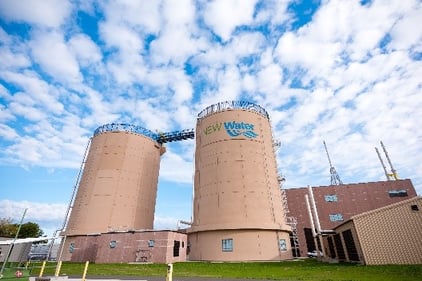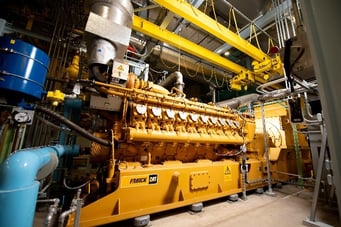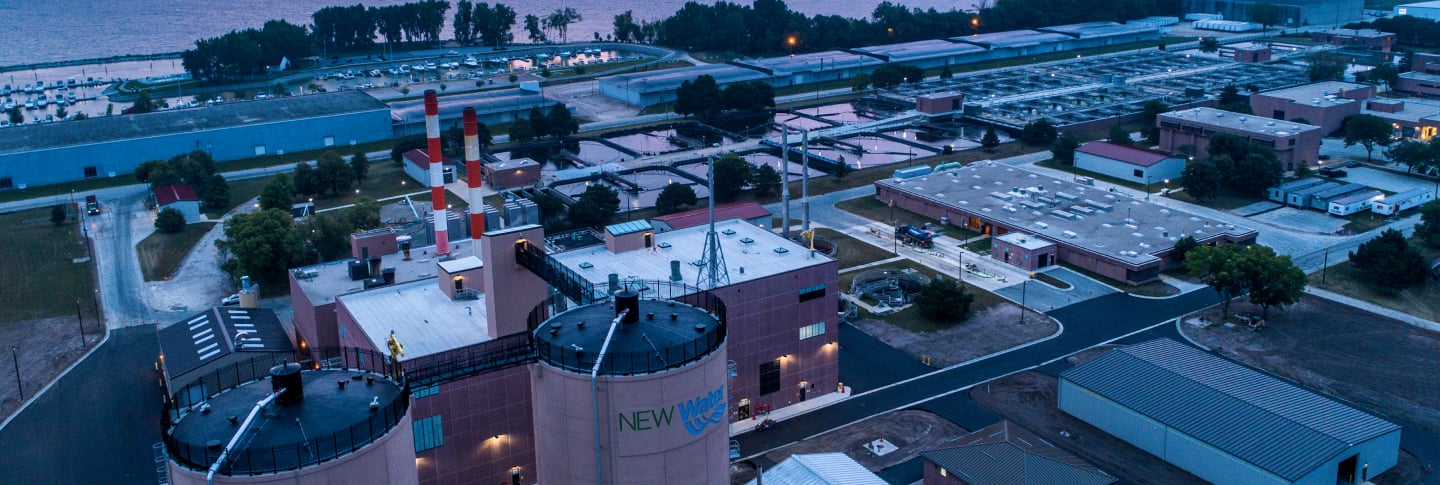How does NEW Water deal with biosolids? By viewing it as a resource to be recovered, rather than something to dispose.
R2E2, or Resource Recovery and Electrical Energy, represents a change in philosophy for NEW Water, the brand of the Green Bay Metropolitan Sewerage District.
When the old solids’ handling facility had reached the en d of its useful life, the utility took the opportunity to factor in resource recovery. With R2E2, the new approach to solids handling harnesses resource recovery of nutrients and biogas for cost savings and environmental benefit. Due to the innovative design, the facility produces about 40% of the electricity needs for the Green Bay Facility, resulting in a reduced carbon footprint and significant cost savings. (Image caption: R2E2’s two anaerobic digesters, used to produce electricity for the facility, which can be seen while driving across the Leo Frigo Bridge.)
d of its useful life, the utility took the opportunity to factor in resource recovery. With R2E2, the new approach to solids handling harnesses resource recovery of nutrients and biogas for cost savings and environmental benefit. Due to the innovative design, the facility produces about 40% of the electricity needs for the Green Bay Facility, resulting in a reduced carbon footprint and significant cost savings. (Image caption: R2E2’s two anaerobic digesters, used to produce electricity for the facility, which can be seen while driving across the Leo Frigo Bridge.)
R2E2 was designed to use fluid-bed incineration with anaerobic digestion to both recover and minimize the use of resources. Anaerobic digestion is used to break down biosolids in the absence of oxygen, after they are settled out during several phases in the liquids portion of the treatment process. Anaerobic digestion recovers energy from biosolids in the form of biogas.
Another resource recovery component to R2E2 is the High-Strength Hauled Waste Program. High-strength waste is typically industrial or commercial wastewater with a high biochemical oxygen demand (BOD) content, such as dairy, sugar, and food-processing waste, which would otherwise be spread onto nearby fields or land-filled. Hauled in from area industries and businesses to NEW Water’s Green Bay Facility, these wastes can increase digester biogas production, further offsetting NEW Water’s energy costs, as well as reducing disposal costs for industries, and providing a consistent and environmentally friendly disposal outlet.
High-strength hauled waste is accepted and fed into the digestion process, which has increased gas production by 25% above what is generated by biosolids alone. Digester gas is used in internal combustion engine generators to produce electricity. Fluidized-bed technology blows hot air through a sand bed to dry and incinerate the biosolids. Air emissions are managed through a pollution control system to remove pollutants as set out by the Environmental Protection Agency and Wisconsin Department of Natural Resources, including particulate matter, mercury, nitrogen oxides, hydrochloric acid, sulfur dioxide, dioxins, furans, and metals.
Ash from the incinerator is sent to a landfill. When the incinerator is undergoing maintenance, biosolids are sent to a landfill. In 2022, about 33,570 tons of biosolids were processed by NEW Water, with about 2,900 tons hauled to a landfill; that amounts to about 9% of the total amount of biosolids sent to NEW Water from the community.
 Another resource recovery process occurs as heat from the engines and incinerator are captured and used for building heat, biosolids drying, and digester heating. (Image caption: R2E2’s internal combustion engine generators use the digester gas to produce about 40% of the electricity needs and heat captured off the engine is used to heat processes at the Green Bay Facility.)
Another resource recovery process occurs as heat from the engines and incinerator are captured and used for building heat, biosolids drying, and digester heating. (Image caption: R2E2’s internal combustion engine generators use the digester gas to produce about 40% of the electricity needs and heat captured off the engine is used to heat processes at the Green Bay Facility.)
Background
Construction of R2E2 launched in 2015, and the facility went online in 2018. NEW Water began processing biosolids using incineration when the 1974 solids handling facility went online, on the heels of the Clean Water Act, which funded wastewater upgrades across the United States. The old system used multiple hearth incineration, which required significant supplemental fuel to operate. NEW Water replaced its old
solids handling facility to meet stricter environmental regulations, address the needs for increased capacity, and to replace aging infrastructure.
Learn more about R2E2, watch the "R2E2: A New Era in Resource Recovery" video below.




